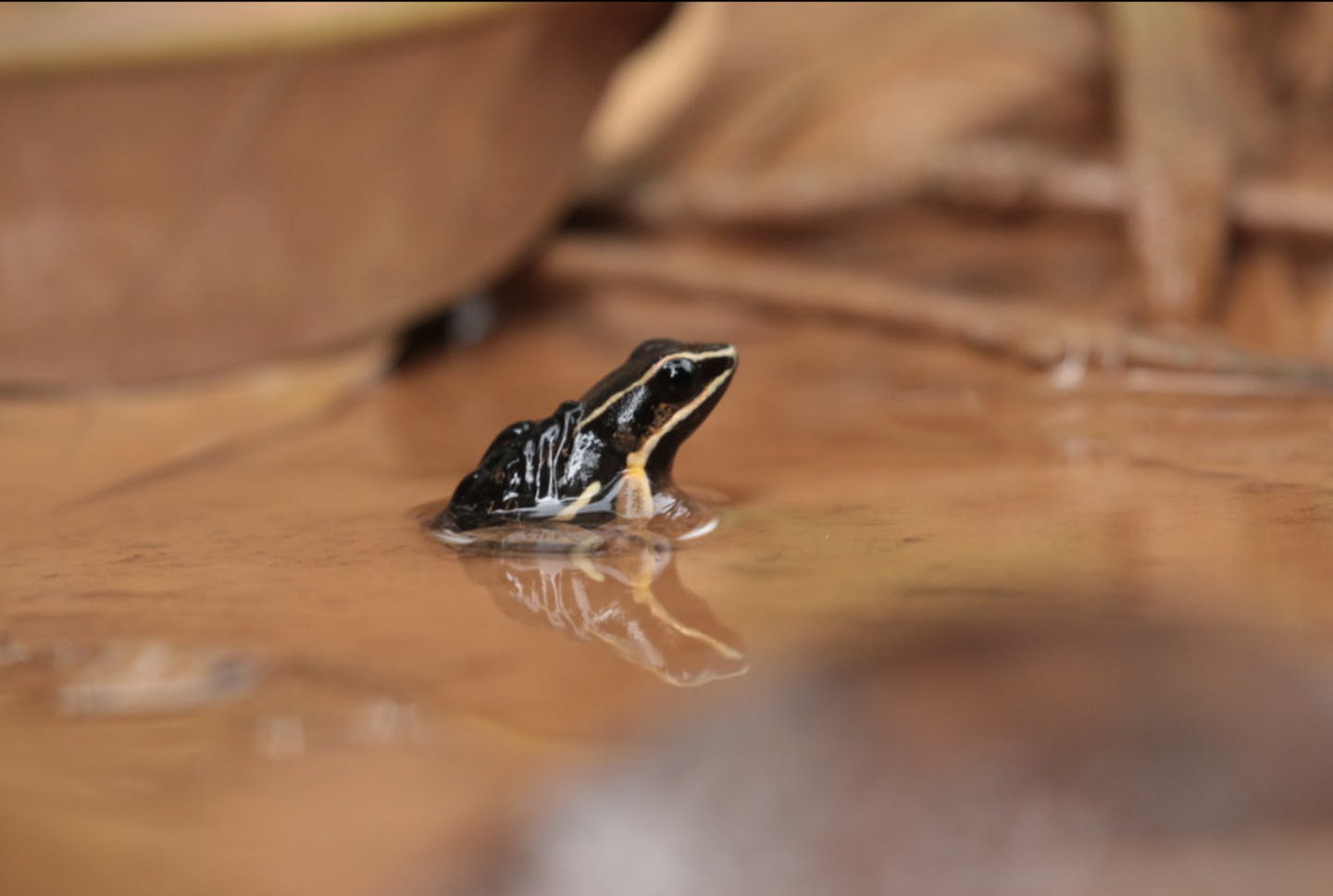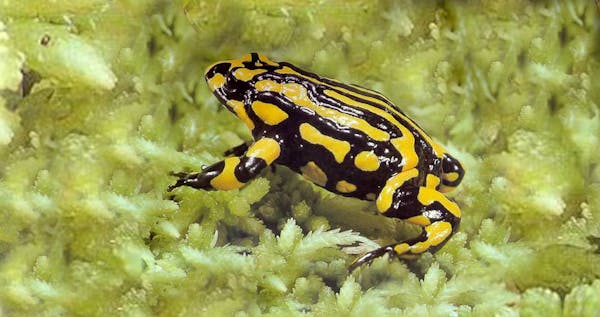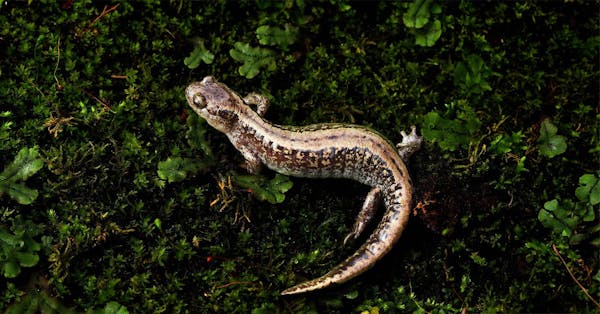Piggybacking through the rainforest: How the brilliant-thighed poison frog parents
- Nature Conservation
- Land Conservation
- Iconic Species
- Wildlife
- Amphibians
- Upper South America
- Southern America Realm
One Earth’s “Species of the Week” series highlights an iconic species that represents the unique biogeography of each of the 185 bioregions of the Earth.
Deep in the lush, dense rainforests of South America, the brilliant-thighed poison frog (Allobates femoralis) stands out for its unique parenting. Despite their small size, these frogs are dedicated caregivers, ensuring their offspring grow up safely and far from the risks of inbreeding.
With their vivid colors and intricate behaviors, these frogs offer a fascinating glimpse into the complexities of rainforest life and their important role in maintaining ecological balance.

Brilliant-thighed poison frogs are the iconic species of Guianan Forests & Savanna bioregion (NT21) located in the Upper South American subrealm of South America.
Their small, but vibrant appearance
The brilliant-thighed poison frog, often overlooked due to its small size, measures between 20 and 45 millimeters (0.75 to 1.5 inches) in length. The females are notably larger, reaching up to the full 45 millimeters.
Their striking appearance, with shiny, granular skin in hues of black, brown, green, or blue, is complemented by distinctive dark stripes flanked by light-colored lines running from snout to hind leg. A bright yellow mark at the joints of their limbs adds to their brilliant display.
Home in the Terra Firme forests
These frogs inhabit the Terra Firme forests of French Guiana, Guyana, and tropical eastern South America, including Colombia, Ecuador, Peru, Bolivia, and Brazil. Terra Firme forests, located on plateaus and high hills, are rich with Satinwood trees, Brazil nut trees, and Huasaí palms. These forests are home to a variety of mammals such as the red brocket deer, collared peccary, black curassow, black spider monkey, and tapir.
Ground-level territorial guardians
The territory of this small frog is at ground level, beneath a shady canopy in plots of about 150 by 150 meters that are rich in thick humus of decomposing leaves, fruits, and twigs. The male is very protective of his small plot, a behavior known as territoriality.
If he hears a male intruder, his androgen levels will increase, and he will engage in a fight. After all, this is the sacred place where he performs his entire parenting cycle, from courtship to caring for the tadpoles and delivering them to where they will metamorphose into juvenile frogs.

The striking appearance and color that gives the brilliant-thighed poison frog its name. Image Credit: Alessandro Catenazzi, Wiki Commons.
The intricate dance of courtship and reproduction
During their very long lifespan of between 12 and 20 years, one male can procure about 250 new frogs from his intercourse with one or two females per season, and they may mate again in successive seasons.
The reproductive behavior of poison frogs is impressively complex. They become sexually active and acquire nuptial traits in the latter portion of the wet season. In this season, and when rain falls, the male’s arms become enlarged, and he begins to emit two kinds of calls: the advertisement call and the low vibrational courtship call. He can wait for days for a female to show interest in this arm-flexing, courtship behavior.
Once a female approaches him, the male begins to ‘walk’ the female around, making sure she stays close and follows him. The male proceeds to show the main attractions of his territory and suggests a few oviposition sites, usually under tree logs or rocks. If the female begins to ‘jump’ away, he approaches her and emits the low vibrational courtship call to persuade her to follow him again.
As the male marches, he displays his throat, inflates his vocal sac, lifts his limbs, and stretches his legs, showing the orange patches on his thighs, and pivoting on his axis like a breakdancer. The female responds by touching her belly with her limbs.
After a long courtship that can take a few days—at times interrupted by a second male intruding the territory—the new couple agrees on a good breeding site. The male then mounts the female and clasps onto her head. Soon, she lays a clutch of about eight to seventeen eggs while the male releases sperm. When the amplexus (or embrace) is over after several hours, the male stays for a couple of minutes and then leaves the site. The female remains for almost an hour before departing.
Devoted dads nurturing the next generation
Over the next few weeks, both the male and female pay frequent visits to the site to check on the eggs and ensure they are not drying out. At this point, males may have more than one clutch of eggs to take care of from different mating partners. It is a busy time, as each male must not only visit the clutches but also scout the margins of the territory in search of one or a few shallow puddles of water that will become the nursery for his babies.
The male’s memory is so sharp that he can return to each of the clutches while remembering where the puddles of water are as well. As soon as the eggs hatch into tadpoles, he lies next to them so that the tadpoles can wriggle up his hind limbs and onto his back.
He then ‘shuttles’ the tadpoles straight to the puddle. Based on his assessment, he might shuttle the next few to the same deposition site or to another one. During the next two months, the little tadpoles feed off rotten vegetation and gradually metamorphose into juvenile frogs. These young ones soon learn to feed off springtails, and once they are adults, they catch beetles, crickets, ants, and roaches.

A brilliant-thighed poison frog dad carrying his tadpoles. Image credit: Leonardo Merçon, iNaturalist UK
Misunderstood: The truth about their toxicity
Poison frogs are commonly called ‘poison arrow’ and ‘poison dart’ frogs due to the belief that South American native hunters rub their arrow tips on the frogs' backs before hunting. However, only three species have been documented as actually being used for this purpose, and none are from the Allobates genus.
Among them is the golden poison frog, the most toxic of all frog species from the Phyllobates genus. This frog consumes the Papuan beetle, which contains an alkaloid that the frog collects in its skin glands. This alkaloid is called batrachotoxin and, despite its poisonous nature, it can also have medicinal properties.
Ecological pillars of the rainforest
The brilliant-thighed poison frog is more than a captivating inhabitant of the rainforest; it plays a vital role in maintaining the ecological balance of its habitat. By controlling insect populations, these frogs contribute to the balance of their ecosystem.
Their presence indicates a thriving, biodiverse environment, essential for the overall health of the rainforest and, ultimately, our shared planet.
Support Nature Conservation-
-
- Research Gate: Landscape patterns influence communities of medium-to large-bodied vertebrates in undisturbed terra firme forests of French Guiana.
- iNaturalist UK: Spotted-thighed poison frog (Allobates femoralis).
- Smithsonian National Zoo: Poison frogs.
-





